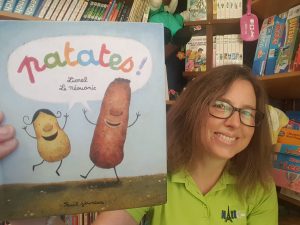
I really need to start making a note of how I acquire my books, because this is another great little story that I have bought/been given second-hand but I am not sure where… You can still buy it though so that is the main thing! (see link at the bottom of the page)
Click here to watch a short video showing you the inside of the book and introducing the story.
Type of text: picture book
Author or source: Lionel Le Néouanic, published by Seuil Jeunesse
Intended age of students: Key Stages 1/2/3
Source reference: 9782020537971
I always start a story by showing the front cover to the children and asking them (in English but could be done in French with certain classes, and a dictionary) what they think the story is about; in this case they will probably only guess potatoes! I would then tell them that it is the story of the day a family of sweet potatoes moved to the land of potatoes, then I would ask them how they think the potatoes would feel about it (good, bad, indifferent, with a show of hands). This would give the children enough background information to understand the story once you read it through to them in French.
As you read the story the first time, you can pause at the 2 pages showing you the family members so the children can say “bonjour” to each one of them, with their names.
On second reading, I would pause at each page (or selected ones) and ask the children how they think one or several characters is/are feeling, in French. This will hopefully encourage empathy. You could let them use the vocabulary that they know or provide them with new adjectives, eg il/elle se sent content.e, heureux.euse, énervé.e.
I would even take different varieties of potatoes into the class to show to the children, as they are probably not aware of how many exist; some may not have seen sweet potatoes before either (see link at the bottom to a French website… all about potatoes!)
I particularly love how the word “rassi” (stale) is used to describe the potato parents’ ideas… It sounds so much like “raciste” (racist). The hints to society in this story are not subtle, they are very obvious to us adults, but may not be to children.
Rationale:
This is a love story… which can be seen as a simplified version of Romeo and Juliet, or of a situation which may unfortunately still arise when someone moves into an area/country that is not the one they originated from. You may even use it to talk about refugees and asylum seekers; the sweet potatoes in the story had to move because their land was too arid.
Outcomes:
This story will really get the children thinking.
You can ask them if they think the potatoes are right to want the sweet potatoes to leave; then you can ask them to think of situations in real life when the same feelings may arise.
The children will also remember the words “pomme de terre” and “patate” and when to use them (more formal/informal).
Topics or themes:
family; multiculturalism; European Day of Languages; refugees; saying how you feel in French
Grammar:
adjectives; possessive adjectives
How much time required:
1 lesson
You can buy the book here at Amazon.co.uk.
Click here for more stories which are especially good for the European Days of Languages and other days when you want children to think of our relationships with others.
There is a French website dedicated to potatoes in France! Click here to find out more about the main type in the story, “Belle de Fontenay”… and much more!
Do you know any other stories with potatoes as characters in them? Funnily enough I know a few… Maybe this will be the topic of another blog! Please share yours in the comments below! Merci !
N.B. Would you like to read about books, ideas, resources and opportunities for the primary languages classroom? Then click here to receive a monthly round up of my blog (and more!) straight in your mail box!

